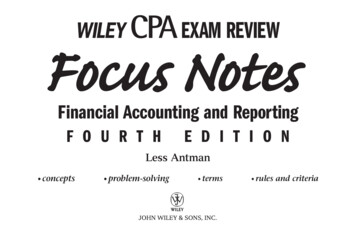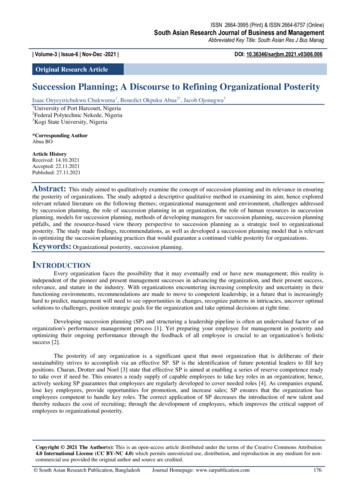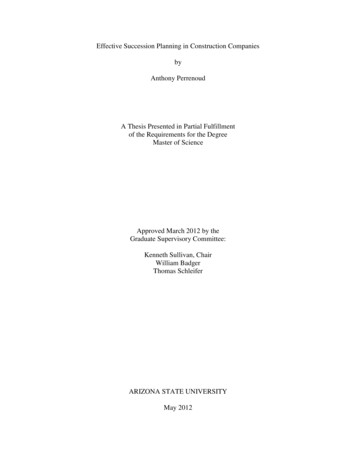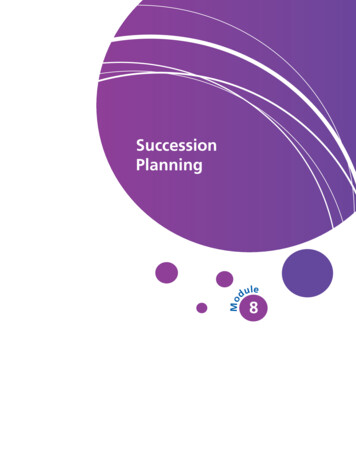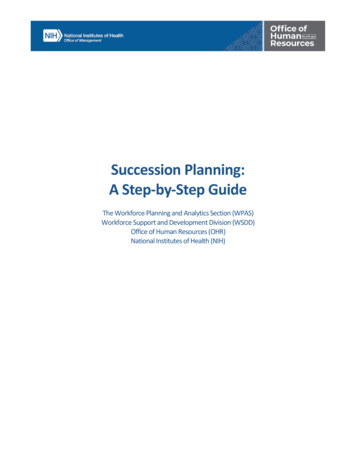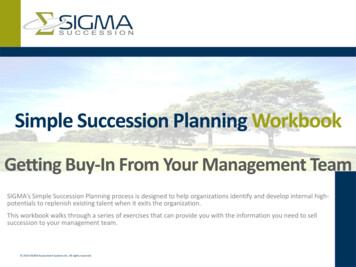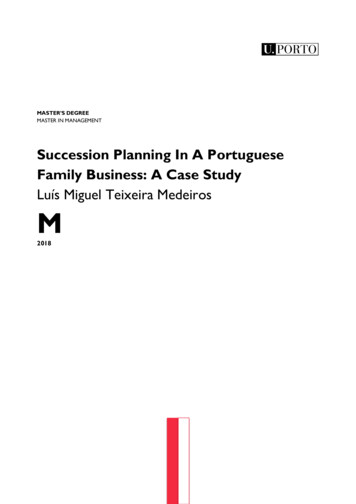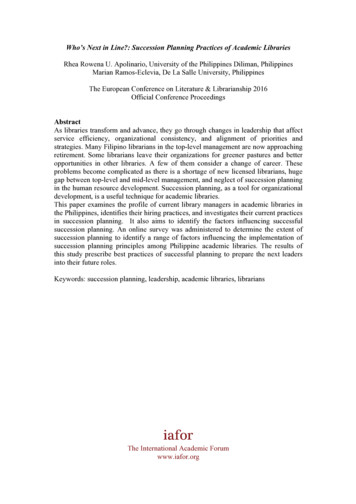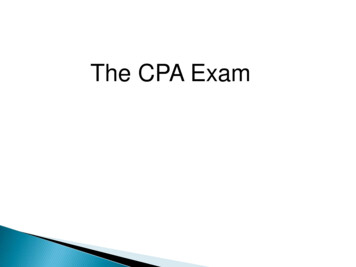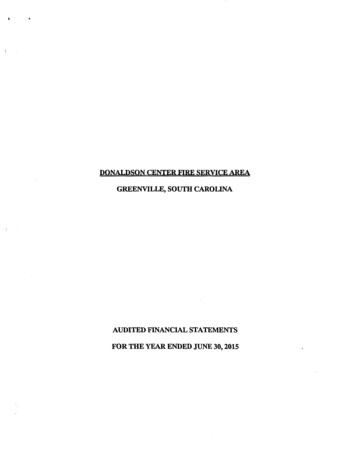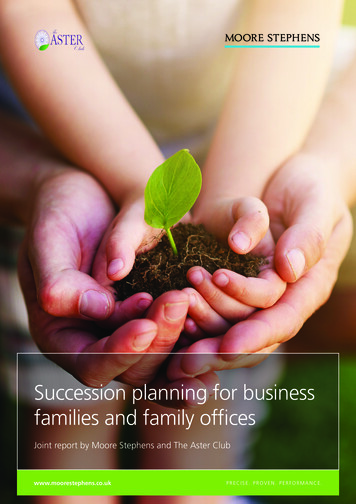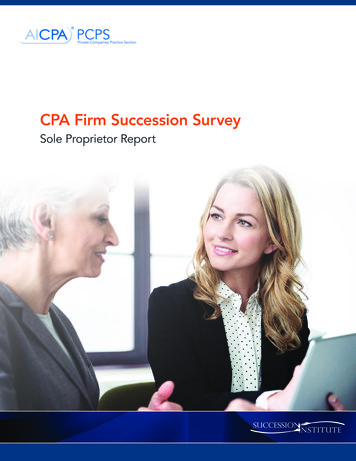
Transcription
CPA Firm Succession SurveySole Proprietor Report
ACKNOWLEDGEMENTSThe Private Companies Practice Section (PCPS) is a voluntary add-on firm membership section of the AICPA that bringstogether CPAs interested in the business of practice management. PCPS partners with more than 6,400 CPA firmsof all sizes nationwide and provides targeted and customizable practice management tools in the areas of technicalresources, business development, human resources, benchmarking and succession planning. The PCPS ExecutiveCommittee, made up of CPA volunteer practitioners, oversees this section and steers programs to help improvethe quality of services and operating success of PCPS member firms. The PCPS Executive Committee promotes theimportance of succession planning by endorsing this periodic survey.The 2015–16 PCPS Executive Committee members are:Laura Coome, South Dakota CPA SocietyGabrielle Luoma, CPA, CGMA, GMLCPA PLLCDirk L. Edwards, CPA, JD, MBA, PFS, EdwardsConsulting LLCRyan M. Maniscalco, CPA, Baker TillyMichael J. Elliott, CPA, Dittrick & Associates Inc.George D. Forsythe, CPA, WellsColemanAmber K. Goering, CPA, CGMA, Goering andGranatino P.A.Stacey Hekkert, CPA, CGMA, Anton Collins Mitchell LLPKaren Kerber, CPA/CITP, CGMA, Kerber, Rose &Associates S.C.Joel Olbricht, CPA, Olbricht Storniolo GroupJeffrey D. Solomon, CPA, CVA, KN SJohanna Sweaney Salt, CPA, CGMA, Gray,Salt & Associates LLPMichael A. Westervelt, CPA, CliftonLarsonAllen LLPCheryl K. Woods, CPA, CGMA, Cheryl K. Woods,CPA P.C. Associates S.C.Dov Zaidman, CPA/CITP, CGMA, ZBS Group LLPAlexandra B. Kessler, CPA, CGMA, Aronson LLCWe are grateful for the remarkable work of our partner, Succession Institute LLC, that once again providedthe survey execution and analysis. Special thanks go to Bill Reeb, CPA/CITP, CGMA, and Dom Cingoranelli,CPA/CGMA, CMC. 2016 American Institute of CPAs. All rights reserved.DISCLAIMER: The contents of this publication do not necessarily reflect the position or opinion of the AICPA, its divisions or committees.This publication is designed to provide accurate and authoritative information on the subject covered. It is distributed with the understandingthat the authors are not engaged in rendering legal, accounting or other professional services. If legal advice or other expert assistance isrequired, the services of a competent professional should be sought.For more information about the procedure for requesting permission to make copies of any part of this work, please emailcopyright@aicpa.org with your request. Otherwise, requests should be written and mailed to Permissions Department, AICPA,220 Leigh Farm Road, Durham, NC 27707-8110
TABLE OF CONTENTSExecutive Summary.2Who Responded.3Practice Continuation Agreements.5Succession Plans.8Value and Payout Terms.10Mergers and Acquisitions. 12Developing Leaders and Increasing the Value of the Firm. 14Key Insights and Best Practices. 16
EXECUTIVE SUMMARYThe need to provide quality services to fuel client relationships and strive for future relationships oftendiverts the attention of firms from important planning tasks — such as succession planning. Whilestriving to maintain a client base, it’s imperative that firms consider how these clients will continue to beserviced as the owners of the firm turnover. Recognizing the importance of succession planning givesfirms the power to set the tone and direction with which they wish to send the firm into the future.This report summarizes selected results of the 2016 PCPS Succession Survey, a joint projectbetween PCPS and Succession Institute LLC. The purpose of this survey is to update the profession’sunderstanding of the challenges succession planning poses for CPA firms, together with the actions CPAfirms are taking to address those challenges. Out of over 800 respondents, over 380 sole proprietor firmsparticipated. Given the depth and breadth of the data captured in the survey, we believe the resultsprovide a clear picture of the state of succession planning for our profession.Comparable to the 2012 results, the majority of sole proprietors continue to operate without practicecontinuation agreements; less than 10% actually have one in place. Additionally, nearly half of participantsindicate that their first choice of exit strategy is to merge into another firm. Considering that ourprofession has roughly 44,000 firms, with about 600 having 21 professionals or more, the merger marketfor small firms is expected to heat up, making succession planning imperative to continued firm success.The marketplace could get softer, however, as the number of firms that will be in play in five years or sogrows.For firms whose owners embrace change as an acceptable path to the future and are on board withpreparing for succession and transitioning the firm in a sustainable fashion, the future is very bright. Theycan map out a route that will accommodate the landslide of ownership change that is just around thecorner. Firms that have begun, or begin now, to prepare, have significant opportunities ahead of them,regardless of firm size. By developing a culture that supports structured, clear paths of staff training anddevelopment, firms will be able to create a viable structure for professionals staff who firm leadership hasconsciously developed and are ready to step up as current leaders step out of the business.We hope the data and commentary provided can serve as a baseline for firms trying to develop theirsuccession plan and a comparison tool for those who already have a plan in place.2 CPA FIRM SUCCESSION SURVEY: Sole Proprietor Report
WHO RESPONDED?This survey report shows the results for CPA firms with only one owner. It includes responses from:Solo practitioners — Individual practitioners with no staffSole proprietors — Single owners of practices that employ staff, either administrative, professional or bothUnless otherwise noted, the statistics and content that follow combine the responses from both solo practitioners andsole proprietors. A total of 384 firms in this category responded to this survey.Respondents, by Net Annual Revenue (NAR) 2,000,001– 5,025,000 750,001– 1,000,000 500,001– 750,000 1– 250,0002% 1,000,001– 2,000,00012%18%11%21%36% 250,001– 500,000Respondents, by Full-Time Equivalents (FTEs)16–50 FTEs8–15 FTEs2%11% 3 FTEs38%3–7 FTEs48%Average Net Annual Revenue (NAR)3 FTEs3 8 FTEs8 16 FTEs16 50 FTEs 228,304 543,147 1,353,987 2,627,143CPA FIRM SUCCESSION SURVEY: Sole Proprietor Report 3
The survey results indicate that practices are staffed as follows: 3 FTEs3 8 FTEs8 16 FTEs16 50 FTEsEquity Owners1111Non-Equity Owners or Income Partners0011Accounting Staff, excluding owners12716Administrative and Para-ProfessionalEmployees11310Average Total *251128*Average Total FTEs — Average sum of all full-time equivalents for firm will not add up to individual averages by position.Owner compensation showed:Average Annual Owner Compensation4 CPA FIRM SUCCESSION SURVEY: Sole Proprietor Report 3FTEs3 8 FTEs8 16 FTEs16 50 FTEs 123,991 183,692 328,027 570,400
PRACTICE CONTINUATION AGREEMENTSA Practice Continuation Agreement (PCA) is a contract between your firm and another firm or person (the successorfirm) wherein the successor firm agrees to take over your practice in the event of certain triggering events. Thosetriggering events usually include your temporary disability, permanent disability, or death. In some cases, the triggeringevents can include a planned exit like your retirement. Here’s how sole proprietors described their intentions regardingsuccession.I currently have an existing practice-continuation agreement with another firm:20162012Yes7%6%No93%94%For those that DO NOT have an existing written practice-continuation agreement with another firm,which most closely reflects the status:2016I feel I should have a practice-continuation agreement, but I don’t really know how toget started putting it together.42%I am interested in creating a practice-continuation agreement in the future, but I don'tfeel the necessity to start it at this time.25%I do not feel the need to have a practice-continuation agreement, written or otherwise.18%I am in the process of working with a firm (or firms) drafting a practice-continuationagreement, but it has not been completed yet.15%Despite the awareness of the need for agreements, making this happen is still a low priority for the vast majority ofsole proprietors. However, PCAs can be essential to the continuity of a firm, especially in the case of unexpectedcircumstances. For more information on PCAs and a sample agreement, please visit Chapter 7 of the PCPS SuccessionPlanning Resource Center (aicpa.org/PCPS/succession).For those that DO have an existing written practice-continuation agreement with another firm, whichstatement below most closely reflects the status:2016I have a practice continuation agreement in place, and I am comfortable that it provides me with theprotection I need.37%I have a practice continuation agreement in place, but I am not comfortable that it provides me with theprotection I need.33%I have a practice continuation agreement in place, and I am comfortable that it provides me with theprotection I need, and I visit it periodically with my takeover firm or firms to ensure it will be effective ifit is needed.30%CPA FIRM SUCCESSION SURVEY: Sole Proprietor Report 5
For those who DO have an existing written practice-continuation agreement with another firm, whattopics are covered:6 20162012The conditions that trigger the agreement (e.g., retirement, death, disability after a specific periodof time, etc.) are clearly identified.100%96%Upon notice of a triggering event (e.g., retirement, death, disability), the agreement clarifies howquickly the responsible party is required to take over the firm.92%69%The party (firm or individual) responsible for buying your firm is clearly identified.80%85%Payment period and terms68%58%Clear formula for calculation of the sales price of the firm (e.g., clients to be included, excluded,method for determining client value, etc.)68%65%Provisions for temporary or short-term disability (outlining the terms should the disability betemporary and the selling owner wants to step in and take back the firm after recovery from thedisability)64%42%Definition of disability required to trigger agreement60%58%When the triggering event is thought to be temporary from the onset, the agreement outlinesthe remuneration to be paid to the firm or person for temporarily stepping in to keep the firmoperating during the recovery period (e.g., percentage of billings, price per hour, etc.)48%27%Non-compete clause in place for disabled or retired owner (e.g., how the individual or firm takingover is protected in cases where the disabled or retired partner decides to compete or lure backold clients)40%38%Plans for existing employees (e.g., an obligation to retain the employee(s) for a certain period)40%31%Client transition requirements (in the case of retirement)36%35%When the triggering event is thought to be temporary from the onset, there are quality controlsoutlined to ensure acceptable standards of work during the recovery period.28%19%CPA FIRM SUCCESSION SURVEY: Sole Proprietor Report
The importance of topics/provisions in a practice-continuation tImportantVeryImportant0%1%5%35%60%Payment period and terms1%0%2%30%66%Clear formula for calculation of the sales price of thefirm (e.g., clients to be included, excluded, method fordetermining value of clients, etc.)1%0%3%26%70%Upon notice of a triggering event, the agreement clarifies howquickly the responsible party is required to take over the firm.0%0%2%32%66%The conditions that trigger the agreement are clearlyidentified.0%0%1%25%73%Non-compete clause in place for disabled or retired owner(e.g., how the individual or firm taking over is protectedin cases where the disabled or retired partner decides tocompete or lure back old clients)2%1%14%36%47%When the triggering event is thought to be temporary fromthe onset, there are quality controls outlined to ensureacceptable standards of work during the recovery period.1%1%9%43%45%When the triggering event is thought to be temporary fromthe onset, the agreement outlines the remuneration to bepaid to the firm or person for temporarily stepping in tokeep the firm operating during the recovery period (e.g.,percentage of billings, price per hour, etc.).2%1%10%39%49%Plans for existing employees (e.g., an obligation to retain theemployee(s) for a certain period)4%2%11%39%44%Client transition requirements (in the case of retirement)1%0%5%41%53%Definition of disability required to trigger agreement1%0%10%38%51%Provisions for temporary or short-term disability (outliningthe terms should the disability be temporary and the sellingowner wants to step in and take back the firm after recoveryfrom the disability)1%1%14%43%42%Not at allImportantThe party (firm or individual) responsible for buying your firmis clearly identified.CPA FIRM SUCCESSION SURVEY: Sole Proprietor Report 7
SUCCESSION PLANSThe following best describes my succession plan, retirement plan or exit strategy:2016I am leaning toward selling my clients to another CPA firm and walking away, while taking actions thatwill help transition my clients to maximize the amount of my payout.29%I am leaning toward merging my firm into another firm a year or two before I want to retire to secure myretirement benefit and client retention.28%I am leaning toward running my practice, working a little less each year, until I don’t want to do the workany longer. When that time comes, I plan to walk away and if I can get someone to buy my remainingclients, great. If not, I am willing to live with that.25%I am leaning toward merging my firm into another firm and working for that firm for a number of yearsuntil I retire.18%When looking at firm size, the choices vary significantly: 3 FTEs3 8FTEs8 16FTEs16–51FTEsI am leaning toward running my practice, working a little less eachyear, until I don’t want to do the work any longer. When that timecomes, I plan to walk away and if I can get someone to buy myremaining clients, great. If not, I am willing to live with that.36%17%21%0%I am leaning toward merging my firm into another firm a year ortwo before I want to retire to secure my retirement benefit andclient retention.25%32%26%40%I am leaning toward selling my clients to another CPA firm andwalking away, while taking actions that will help transition myclients to maximize the amount of my payout.24%34%33%0%I am leaning toward merging my firm into another firm andworking for that firm for a number of years until I retire.15%17%21%60%All firms (100%) with 16 people or more are only considering a merger option, while firms with three people orfewer are the most likely to walk away from the firm if they can’t find a buyer when they are done. As the firmsgrow larger, the owner’s asset (firm value) becomes more significant and more complex (sustaining revenues,taking care of long-time clients, providing a new home for staff, the assets — such as equipment, furniture, alease or ownership in a building, etc.). These owners plan on staying involved longer with the new firm to helpwith the transition, as well as protect the value of that asset.8 CPA FIRM SUCCESSION SURVEY: Sole Proprietor Report
What is your approximate planned timing to fully retire or exit your practice?in more than 15 years10%in 11–15 yearsin 6–10 years17%40%within 5 years33%The average number of years until retirement for the group was about eight years.At what age are you expecting to fully retire or exit from the practice?Under 55 years old55–59 years old2%75 years old16%70–74 years old32%4%60–64 years old11%35%65–69 years oldThis data indicates that sole proprietors are planning on retiring at ages well beyond the owner mandatory retirementages found in most multi-owner firms. The average retirement age for this group is 68, with 48% of the respondentsplanning on retiring at age 70 or older. When you consider the number of sole proprietors who plan to walk away whendone with their firm, it makes sense that people plan to work longer, cutting back their hours as they get older, andworking until they just don’t want to do it anymore.CPA FIRM SUCCESSION SURVEY: Sole Proprietor Report 9
VALUE AND PAYOUT TERMSValuation of the Book or PracticeThe dollar amount I expect, as a ratio of client billings for my practice, is:2016201290 cents or fewer paid22%20% 149%48% 1.106%10% 1.2011%11% 1.30 or more12%11%When it comes to a sale or merger, the size of the firm may not matter as much as the quality of the practice.The quality of the practice will include considerations such as:The nature and quality of the clients and service offeringsEffective hourly rate realized for work performedLeverage and quality of personnel in the practiceSpecific niche services offeredStrategic geographic locationOther factorsA sole owner who has kept his or her rates and fees up in local market might expect to realize more from a sale than onewho has chosen to discount the work performed and just work harder to make up for the billing shortfall.At the same time, the expectations of many practitioners will not be realized when the time comes for a sale. Given thedemographics of the profession and the number of practices that could be in transition, we expect to see a buyer’smarket emerge toward the end of this period. As time passes, most sole proprietors may not be able to negotiate formore than 1 for 1 of client billings retained. As a practice changes hands, there is the strong likelihood of some clientattrition from clients not wanting to move to the acquiring firm. Additionally, many clients who have enjoyed belowmarket pricing may leave if the acquiring firm raises prices to meet their standard fees.The acquisition landscape is changing as many firms are getting smarter due to recent experiences in the acquisitionmarket. Many acquiring firms pay the seller based on client retention and the billings/collections per client at the timeof sale. Selling CPAs probably won’t be paid for any additional fees the acquiring firm bills a retained client above whatwas being collected from that client at the time of the sale. For example, if client A in the selling firm was billed 10,000in the years leading up to and including acquisition, and then the acquiring firm collects 20,000 from that sameclient due to additional services performed or increased rates, sellers will likely find they don’t get to participate in theadditional dollars billed to their old clients. However, they are generally “charged” for revenues lost from clients that arenot retained by the acquiring firm.The combination of likely lowering market rates (i.e., dollar paid for dollar of revenue dropping below what is being paidtoday) and loss of clients due to attrition, as well as capping revenues billed per client, means a seller’s end price in thenext four or five years could easily net down to 50 or 60 cents on the dollar.10 CPA FIRM SUCCESSION SURVEY: Sole Proprietor Report
Payment TermsThe number of years over which I expect to be paid for my practice:20162012At the time of sale13%N/A1–4 years34%43%5–9 years44%49%10 years9%8%Although many sole proprietors expect to be paid up-front, survey results show that the buyers are following adifferent playbook than the sellers are anticipating.As is the case with expectations for receiving more than 1 for every dollar of revenue billed, it is unrealistic toexpect to receive a buyout over a payout period of less than four to five years, unless the size of the client bookbeing purchased is very small. Sole proprietors also can expect their payout to be paid out over time with theamount contingent on client retention by the acquiring firm. The payout amount generally will have a ceiling inwhich the amount paid will not exceed the amount the selling CPA generated in fees or total book of businessleading up to the time of sale, regardless of what the buyer can generate in fees with that same book of clients.To take deeper dive in this area, see full survey results for at aicpa.org/pcps/succession.CPA FIRM SUCCESSION SURVEY: Sole Proprietor Report 11
MERGERS AND ACQUISITIONSHave you been in an active merger or acquisition discussion in the past 24 months?2016Yes23%No77%When comparing these results for sole proprietors with the survey responses from the multi-owner firms, we find thatthe number of smaller firms that have not been in merger or acquisition discussions is much higher than the multi-ownerfirms. However, more firms are starting to focus on acquiring or merging in these smaller, single-owner firms as part oftheir growth strategy.Which of the following best describes your role in the merger and acquisition discussions?2016My firm is the “mergee” (the firm being acquired).54%My firm is the “mergor” (the acquiring firm).32%Both of the above: I have had discussions with firms when my firm was the one to beacquired as well as when my firm was to be the acquirer of another firm.14%What is the target size in annual revenues of firms you are looking to acquire? Check all that apply.2016About 25% of my annual revenues47%About 50% of my annual revenues34%About 75% of my annual revenues18%About the same size as my annual revenues26%150% or more of my annual revenues24%What is the optimum size in firm revenues of the acquisition targeted you are looking to acquire?2016 1– 300,00053% 300,001– 750,00031% 750,001 16%Small firms may be less attractive to a significantly larger firm because the internal cost to deliver services at the largerfirm may make it unlikely the larger firm can bill the small firm clients at a high enough rate to make the acquisitionprofitable. Larger firms will continue to assess acquisitions of smaller firms that remain in the same general market withsimilar billing structures, providing an opportunity for a successful client transition.12 CPA FIRM SUCCESSION SURVEY: Sole Proprietor Report
Which best describes your expectation regarding financing the sale of your firm?2016Down payment with a fixed amount based on annual revenues at the time of sale tobe paid over a specific number of years38%Down payment with an amount based on revenues for clients retained by thebuying firm to be paid over a specific number of years28%Payment in full up front based on annual revenues at the time of sale16%No down payment, but a fixed amount based on annual revenues at the time of saleto be paid over a specific number of years8%No down payment with an amount based on revenues for clients retained by thebuying firm to be paid over a specific number of years7%Other3%Which best describes the number of practices you have acquired in the past four (4) years?2016I have not acquired any other practices.83%I have acquired one or more practices.17%Which best describes your approach to purchasing the firms you have acquired?2016Down payment with an amount to be paid over a specific number of years based onrevenues for clients retained by the buying firm37%No down payment with an amount to be paid over a specific number of years basedon revenues for clients retained by the buying firm31%Down payment with a fixed amount to be paid over a specific number of yearsbased on annual revenues at the time of sale18%Other8%Payment up front in full based on annual revenues at the time of sale5%No down payment but a fixed amount to be paid over a specific number of yearsbased on annual revenues at the time of sale2%There is a considerable gap between what sole proprietors expect to receive for their practices, as well as theterms of the deal, compared to what currently is happening in the market. This gap may widen even more asbaby boomers retire in larger numbers in the coming years and try to sell their practices.CPA FIRM SUCCESSION SURVEY: Sole Proprietor Report 13
DEVELOPING LEADERS AND INCREASING THE VALUE OF THE FIRMWhat are you doing to make your firm more profitable, increase its value, or make it moreattractive to an external buyer?2016Increasing fees/billing rates70%Streamlining workflow and processes62%Leveraging technology whenever possible61%Improving the overall profitability of the firm56%Delegating — handing off lower level work54%Training your people49%I am happy where I am, I am not worried about making changes and am doing what I have always done asthat is working for me.46%Growing the overall top line46%Improving client base by: (1) firing low-quality clients (those that don’t pay on time, abuse staff’s time,etc.); (2) converting lower-quality clients (smaller clients that have fewer needs, such as a tax return,financial statement or bookkeeping) to higher-quality clients (those that utilize more of your firm’sservices, are more profitable to the firm, actively promote your firm, don’t argue about fees, and valueyour involvement); and (3) by going after more higher-quality clients45%Growing the overall bottom line44%Utilizing more than one billing rate to recover for the inefficiencies that are present in various linesof service44%Hiring someone (even if you are currently a solo practitioner and only bring in someone part time) toprovide one more contact point for your clients as well as free you up to just do the higher level work34%Recording all of your time to better understand the actual cost of servicing a client instead of notrecording the time due to the assumption that you won’t bill it anyway32%Acquiring larger and/or more sophisticated clients28%Stop giving away work in the slow periods to keep busy26%Embracing and implementing the Trusted Business Advisor or the Business General Contractor rolewithin your firm where you proactively get out in front of your top clients three to four times a year to seepersonally what is going on in their operations and gain an understanding of the non-tax, non-financial,general management challenges and opportunities they are facing and what they are attempting to doabout them23%Updating your compensation system to better focus people on the activities you want them to focus upon17%Owners contemplating merging or selling their firm in the next few years should take a look at every item onthis list and do what they can to make progress in these areas. It will make a difference in the number of firmsinterested in their practice, and therefore, the price they ultimately receive for their practice.14 CPA FIRM SUCCESSION SURVEY: Sole Proprietor Report
What I am doing right now to develop future leaders of my firm:20162012Identification of, and training for, specific competencies (preferably based on a competency model)37%39%Nothing is being done at this time24%52%No employees or partners to develop at this time22%N/AFormal training or education in soft skills like management, assertiveness, handling conflict,communication, change, etc.19%N/AFormal training or education in management and delegation18%18%Experiential assignments chosen to develop competencies17%23%Formal in-firm mentoring program10%6%State society formal staff training programs10%N/AFormal in-firm staff training programs9%N/AAICPA formal staff training programs8%N/AFormal in-firm coaching program7%N/AState society formal leadership (partner or manager) development programs5%3%Formal CPA consultant led coaching program4%4%Formal in-firm partner or manager development programs4%2%CPA consultant offered formal leadership (partner and manager) development programs3%N/AAICPA formal leadership (partner or manager) development programs3%1%CPA firm association formal leadership (partner or manager) development programs2%1%CPA firm association formal staff training programs2%N/ACPA FIRM SUCCESSION SURVEY: Sole Proprietor Report 15
KEY INSIGHTS AND BEST PRACTICESThe 2016 Succession Survey provided useful information regarding the current status and future implementation goalsfor CPA firm succession plans. Key insights into the succession planning status for sole proprietors include:There doesn’t appear to have been much movement in the number of sole-owner firms executingpractice-continuation agreements or internal succession planning since the 2012 surveyFirm owners in this group seem to plan on working longer40% of owners plan on retiring in the next five yearsThey seem to expect to be able to sell for more than the market is currently paying, with terms more favorable thanthe market is offeringWith these insights in mind, planning for retirement and eventual transition can be an emotional and undertaking. Tobest prepare your firm consider stepping into the process slowly using the following best practices:Determine your preferred exit strategy– Internal succession– Sale or merger — Know your firm’s value. It’s never too early to begin positioning your firm for a successiontransition– “Turning out the lights” — Even with this option, there will be actions to take in order to ensure a smooth transitioninto retirementNavigate the firm forward by developing and implementing a three-year formal succession plan. Begin by noting keymilestones needed to move your practice forward, considering:– Client transition — Identify marginal clients and either motivate them to become g
Recognizing the importance of succession planning gives firms the power to set the tone and direction with which they wish to send the firm into the future. This report summarizes selected results of the 2016 PCPS Succession Survey, a joint project between PCPS and Succession Institute LLC. The purpose of this survey is to update the profession's
